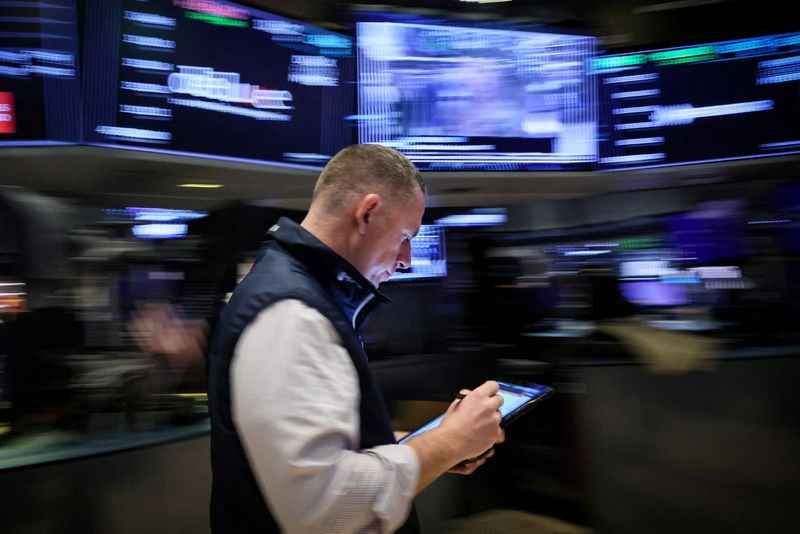By Naomi Rovnick
LONDON (Reuters) – Fear that interest rates in major economies will stay relatively high is creeping back and threatens a painful wake-up call for financial markets, big investors warn.
With traders laser-focused on expected summer rate cuts, global stocks remain near record highs and demand for debt issued by the riskiest companies is firm.
But asset managers and economists now expect only minimal monetary easing, especially from a U.S. Federal Reserve facing unexpectedly persistent inflation.
Big investors are not rushing to change long term holdings, but in a sign of things to come stock market volatility is around a six-month peak as traders debate how high the U.S. rate hurdle against which financial assets are valued will stay.
Global stocks will suffer “a valuation drag from higher for longer rates,” said Ann Katrin-Petersen, senior investment strategist at the BlackRock Investment Institute, the research arm of the world’s largest asset manager.
Amundi, Europe’s largest asset manager, said in a note on Monday that U.S. stocks will lag globally for the next decade. It expects the equity and debt of companies in developing nations such as high-growth India and mineral-rich Chile and Indonesia to outperform.
“Everyone is so focused on when rate cuts are coming,” BNY Mellon chief economist Shamik Dhar said. “The much bigger question is what is the average level we can then expect rates to cycle around.”
Traders, who since 2009 have become used to low rates flattering asset prices, are set for “an adjustment in expectations, psychology and beliefs”, Dhar added.
NEW REGIME
The International Monetary Fund said on Tuesday that the Fed funds rate could fall more slowly than markets now anticipate.
BlackRock’s Petersen forecasts U.S. rates of close to 4% for the next five years and about 2% for the euro zone. “We have entered a new macro market regime and one of the cornerstones of that regime is structurally higher rates,” she said.
World stocks are up about 4% this year, hitting record highs in March. And an index of global junk bonds issued by indebted firms is around its highest since 2021, bolstered by hopes the Fed will lower rates from a 23-year high of 5.25% to 5% – keeping global borrowing and investment conditions exuberant.
But up for reassessment is the discount rate investors plug into company valuation models, which follows long-term U.S. rate expectations. A one percentage point rise in this yardstick depresses the present value of companies’ future earnings by 10%, accountancy firm EY estimates.
Stock prices, especially U.S. ones, are too high, investors said.
Wall Street’s S&P 500 index, which influences equities worldwide, is priced 32% above fair value based on long-term rate forecasts, says Vanguard, the world’s second largest money manager.
“When you do the global return exercise, the 10-year exercise, future returns are (going to be) less than what we’ve had, mathematically,” said John O’ Toole, head of multi-asset solutions at Amundi.
Ten-year Treasury yields, at around 4.5%, already predict a higher discount rate.
Risky assets are holding up partly because the cost of capital that investors plug into company valuation models reflects cheap loan rates agreed previously, Vanguard senior economist Qian Wang said.
With U.S. rates expected to settle around 3.5% and a wave of corporate refinancing coming in 2026, she added, “investors will be disappointed”.
TRADING THE SHIFT
Ageing populations, a shrinking workforce and Western economies re-shoring production from China are expected to keep inflation and rates elevated.
Escalating Middle East conflict has pushed oil near $90, as ongoing climate shocks threaten to keep commodity prices high.
Markets are pricing fewer than two Fed rate cuts this year. The first European Central Bank cut is priced for June, but traders have reduced bets for how far it can go.
BlackRock’s Petersen said the group was neutral on stocks, preferred inflation-linked debt and viewed long-term government bonds as vulnerable to volatile inflation.
Tom Lemaigre, who manages 7.7 billion pounds ($9.58 bln) worth of European equities at Janus Henderson, said he may add to positions in banks, which do well from high interest rates.
He has also turned more positive on European industrial exporters that benefit from a strong dollar and the U.S. expanding domestic manufacturing.
The shift towards high long term rates becoming embedded in traders’ thinking is “yet to come”, Lemaigre added.
Still, the closely-watched VIX gauge of U.S. stock volatility has marched up to a reading of about 19 after slumbering for at ultra-calm levels for months while the comparable bond index is moving higher, as unease grows.
“If markets move from thinking there will be two (Fed) cuts, to one then to (predicting) a hike, it will be really hard for the equity markets to survive that,” said Richard Dias, a strategist at PGM Global in Montreal.
(Reporting by Naomi Rovnick; editing by Dhara Ranasinghe and Mark Heinrich)

